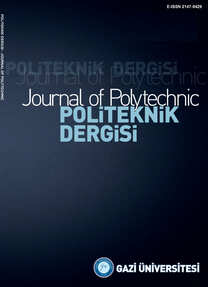Design Improvements by Using the Design for Assembly (DFA) Method in Elevator Production
Design for Assembly, Boothroyd - Dewhurst Method, Elevator Production
Design Improvements by Using the Design for Assembly (DFA) Method in Elevator Production
___
- [1] Molloy O., Warman E.A. and Tilley S., “Design for manufacturing and assembly: concepts, architectures and implementation”, Springer, US, (2012).
- [2] Uslu Divanoglu S., Tas U. ve Pak E., “Application of Methodology of Kaizen in Assembley Line in a Production Facility in Automotive Sector”, Politeknik Dergisi, 24(4):1533-1541,(2021).
- [3] Boothroyd G., Dewhurst P. and Knight W.A., “Product design for manufacture and assembly”, 2nd ed. Marcel Dekker, New York, US, (2002).
- [4] Desai, A., Mital, A., “Facilitating design for assembly through the adoption of a comprehensive design methodology”, International Journal of Industrial Engineering, 17(2): 92 – 102, (2010).
- [5] Imrak C.E., Salman O., “Design of elevator cabin doors suitable for assembly”, 2nd National Design, Manufacturing and Analysis Congress, Balıkesir, Turkey, 272 – 280 (2010). (In Turkish).
- [6] Imrak C.E., Kocaman M., “Design optimisation of elevator car for double deck system”, 9th Int. Congress Machines, Technologies, Materials MTM2012, The Scientific-Technical Union of Mechanical Engineering, Bulgaria, 99 – 102, (2012).
- [7] Cabello Ulloa M.J., Remirez Jauregui A., Zulaika Munain I., Areitioaurtena Oiartzun M., Retolaza Ojanguren I., Campos Insunza M,A. and Martínez Noguera F., “New integrative approach to existing design for assembly (DfA) metodologies: application on elevator components”, DS 92: Proceeding of the Design 2018 15th Design Conference, The Design Society a Worldwide Community, Dubrovnik, Croatia, 215-224, (2018).
- [8] Favi C., Germani M. and Mandolini M., “Design for manufacturing and assembly vs. design to cost: toward a multi-objective approach for decision-making strategies during conceptual design of complex products”, Procedia CIRP, 50: 275 – 280, (2016).
- [9] Suresh P., Ramabalan S. and Natarajan U., “Integration of DFE and DFMA for the sustainable development of an automotive component”, International Journal of Sustainable Engineering, 9(2): 107-118, (2016).
- [10] Gao S., Low S.P. and Nair K., “Design for manufacturing and assembly (DfMA): a preliminary study of factors influencing its adoption in Singapore”, Architectural Engineering and Design Management, 14(6): 440-456, (2018).
- [11] Remirez A., Ramos A., Retolaza I., Cabello M., Campos M. and Martinez F., “New design for assembly methodology adapted to large size products: application on a solar tracker design”, Procedia CIRP, 84: 468–473, (2019).
- [12] Ezpeleta I., Justel D., Bereau U. and Zubelzu J., “DFA-SPDP, a new DFA method to ımprove the assembly during all the product development phases”, Procedia CIRP, 84: 673–679, (2019).
- [13] Gao S., Jin R. and Lu W., “Design for manufacture and assembly in construction: a review”, Building Research & Information, 538 – 550, (2019).
- [14] Naga Malleswari V., SurendraBabu B. and Praneeth C., “Redesigning of electric plug for assembly time reduction using DfA”, Advances in Applied Mechanical Engineering, Lecture Notes in Mechanical Engineering, Springer, Singapore, 1179 – 1187, (2020).
- [15] Çetin H., Arcaklıoğlu E. ve Çetin R., “Soğuk haddehane montaj sürecinin verimliliğinin artırılması”, Politeknik Dergisi, 23(4): 1245-1253, (2020).
- [16] Aydınlı M., “Design for assembly practise in machine production”, MSc Thesis, Pamukkale University, Institute of Science, Denizli, Turkey, (2020). (In Turkish).
- [17] Adam A., Shukor A.I.A., “Evaluation of design efficiency using boothroyd dewhurst method for pcb drilling machine products”, International Journal of Simulation: Systems. Science & Technology, 19(5): 35 – 41, (2018).
- [18] Koç Ö., Top N., Eldem C., Gökçe H. ve Şahin İ. “Ergonomics assessment and redesign of helicopter transmission assembly fixture using digital human models”, Politeknik Dergisi, 24(3): 1197-1203, (2021).
- ISSN: 1302-0900
- Yayın Aralığı: 6
- Başlangıç: 1998
- Yayıncı: GAZİ ÜNİVERSİTESİ
Software-based wind energy potential assessment: a case study from western Turkey
Fatma Kadriye Düden ÖRGEN, Ayça ALTINTAŞ, Sezai YAŞAR, Murat ÖZTÜRK, Erdem ÇİFTÇİ, Azim Doğuş TUNCER
Bahadir ACAR, Abdullah DAĞDEVİREN, Prof. Dr. Mehmet ÖZKAYMAK, Abdillahi Robleh GUİNALEH
Soğutma Sistemlerinde R454C Kullanılmasının Deneysel İncelenmesi
Atilla Gencer DEVECİOĞLU, Vedat ORUÇ
Hastanelere Aşı Dağıtımı İçin Uygun Rotaların Belirlenmesi: Ankara İli Örneği
Beste DESTİCİOĞLU, Kemal Gürol KURTAY, Aygün ALTUNDAŞ, Hakan Ayhan DAĞISTANLI
NaBH4 Hidrolizi İçin Al2O3 Destekli Çok Bileşenli Nanokatalizör Sentezi ve Kinetik Değerlendirmesi
Çetin ÇAKANYILDIRIM, Gamze GÖKÇEOĞLU
Betonarme Kirişlerin Moment-Eğrilik ve Etkin Kesit Rijitlkleri
Saeid FOROUGHİ, Bahadır YÜKSEL
Meryem GÖREN, Hatice Begüm MURATHAN, Nihan KAYA, Atilla M. MURATHAN
Design Improvements by Using the Design for Assembly (DFA) Method in Elevator Production
